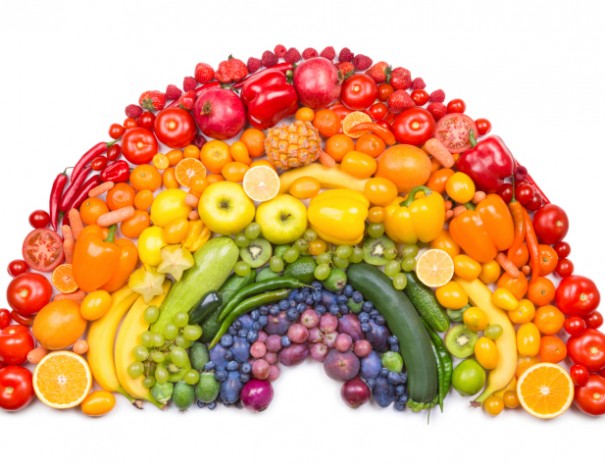Did you know eating healthy was as easy as following the rainbow?

By making it a habit to have 5 colors on your plate for each meal you will automatically be incorporating more fruits and vegetables into your diet. Here is a little breakdown of the importance of each color on your plate.
Green:
Green vegetables are rich in phytochemicals that improve your health and offer plenty of fiber. They also pack in vitamin K, folic acid and potassium, and are good for your eyes, bones and teeth.
Other green vegetables and fruits have potassium, which is great for you heart.
Red:
It is the phytochemical lycopene that is responsible for the red color in fruits and veggies like tomatoes, strawberries, raspberries, watermelon and pink grapefruit. Lycopene has been associated with a decreased risk of cancer, heart disease and even certain eye disorders.
Yellow and Orange:
The yellow/orange group is rich in beta carotene, vitamin A, and vitamin C and includes fruits and vegetables like carrots, mangos, pumpkins, cantaloupe, winter squash, sweet potatoes and peppers. In the body, beta carotene converts into vitamin A, which is good for vision and eye health, healthy skin and an overall strong immune system. Beta carotene is also believed to help prevent memory loss and to protect the skin from sun damage.
Studies even link high consumption of specific carotenoids like beta-cryptoxanthin, which is found in orange and yellow foods, to a lower risk for developing inflammatory arthritis.
Blue and Purple:
Blue and purple vegetables and fruits are some of the most nutritious and most overlooked. They are protective against some cancers, and good for urinary tract health and maintaining memory function.
Many of these blue and purple foods are rich in the phytonutrient anthocyanin, another type of flavonoid that is great for fighting the damage that daily living does to your cells.
White:
Cauliflower has many of the nutrients of other cruciferous vegetables, but it’s the only one that is white. Others on the white list like onions and garlic are considered super foods for their amazing health benefits.
Onions are a great prebiotic; they feed the probiotics (good bacteria and yeast) in your intestines. Onions and garlic are both members of the Allium family. They can lower blood sugar and have amazing anti-inflammatory and anti-bacterial properties.
Don’t let this overwhelm you! The key is to get more vegetables in your diet and there are a lot of great recipes out there! Who is up for the 5 color challenge?


